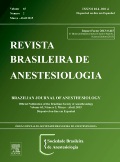
ARTHROPLASTY
TKA: Ultrasound- and nerve stimulator-guided continuous femoral nerve block vs. PCEA
Braz J Anesthesiol. 2015 Jan-Feb;65(1):14-20.46 patients scheduled for total knee arthroplasty were randomized to receive either an ultrasound and nerve stimulator guided continuous femoral nerve block (CFNB) analgesia, or patient control epidural analgesia (PCEA). The purpose of the study was to examine the efficacy of continuous femoral nerve block in terms of VAS pain scores, range of motion, level of sedation, further analgesics required, ability to sleep, muscle strength, side effects, time required to resume walking, and time in hospital, as compared to patient control epidural analgesia. Based on the results of this study, continuous femoral nerve block was the more favourable approach with less pain at 6 and 12 hours postoperatively, greater muscle strength, lower use of parecoxib, and less time required to resume walking.
Unlock the full ACE Report
You have access to {0} free articles per month.Click below to unlock and view this {1}
Unlock NowCritical appraisals of the latest, high-impact randomized controlled trials and systematic reviews in orthopaedics
Access to OrthoEvidence podcast content, including collaborations with the Journal of Bone and Joint Surgery, interviews with internationally recognized surgeons, and roundtable discussions on orthopaedic news and topics
Subscription to The Pulse, a twice-weekly evidence-based newsletter designed to help you make better clinical decisions
Exclusive access to original content articles, including in-house systematic reviews, and articles on health research methods and hot orthopaedic topics
Or upgrade today and gain access to all OrthoEvidence content for just $1.99 per week.
Already have an account? Log in


Subscribe to "The Pulse"
Evidence-Based Orthopaedics direct to your inbox.
{0} of {1} free articles
Become an OrthoEvidence Premium Member. Expand your perspective with high-quality evidence.
Upgrade Now












































































